International HRM Consulting: Case Study of No Name Aircraft Issues
VerifiedAdded on 2023/03/31
|12
|2751
|277
Case Study
AI Summary
This case study examines the Human Resource challenges faced by 'No Name' Aircraft, an international company operating in Australia, China, Singapore, and Vietnam. The analysis identifies critical issues such as a negative organizational culture, communication breakdowns, ineffective quality management, poor diversity management, and a lack of performance management systems. The report proposes strategic International Human Resource Management (IHRM) initiatives to address these concerns, including restructuring HR policies, empowering employees through career development, promoting diversity and inclusion, improving communication flow, and implementing traditional training programs. The recommended IHRM plan incorporates a gap analysis to assess existing skills and competencies, restructures work design for effective communication, establishes inclusive recruitment policies, implements performance management strategies, and emphasizes traditional training and development to align employee motives with organizational objectives. The goal is to foster a culture of trust, flexibility, and continuous improvement within 'No Name' Aircraft.
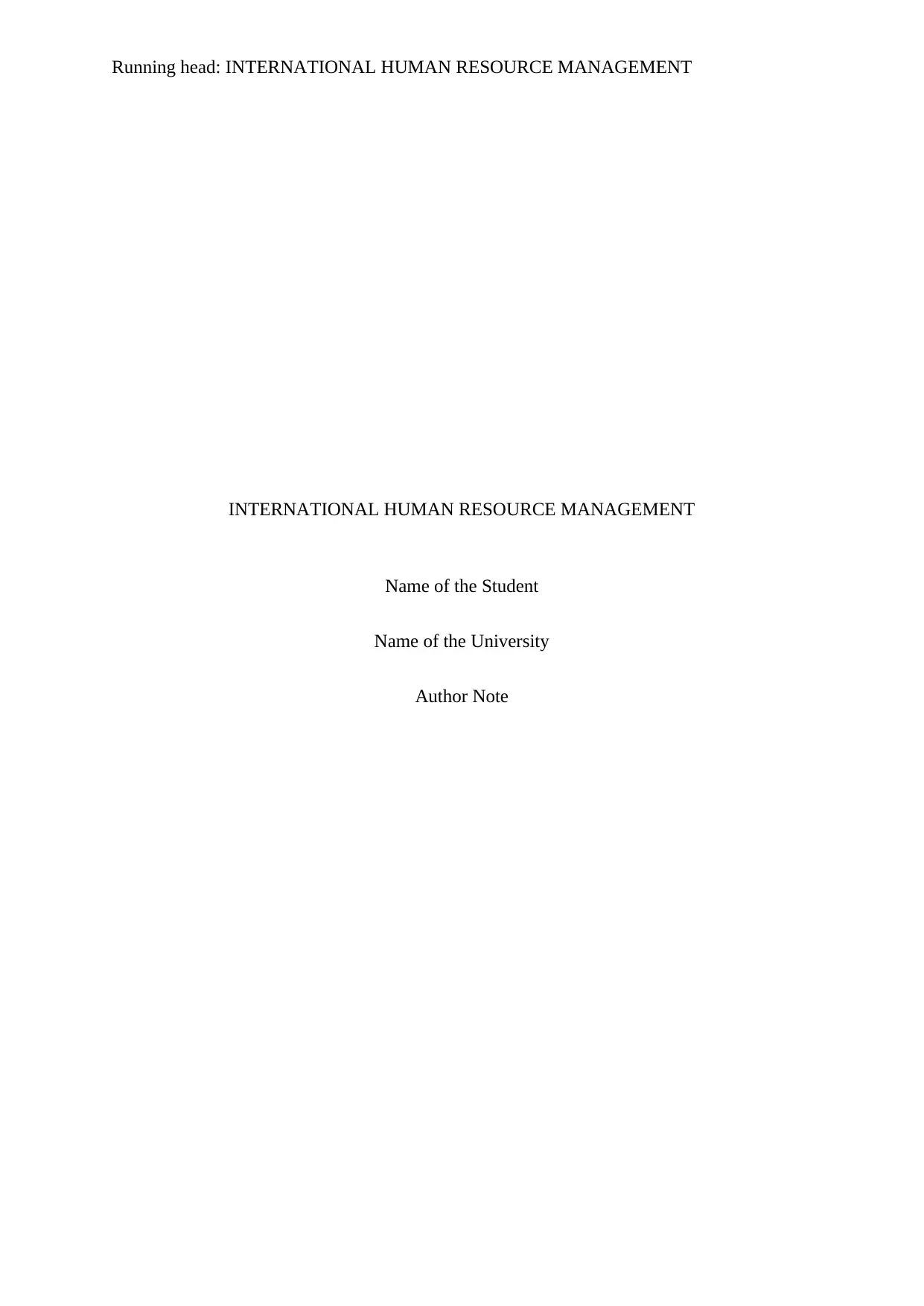
Running head: INTERNATIONAL HUMAN RESOURCE MANAGEMENT
INTERNATIONAL HUMAN RESOURCE MANAGEMENT
Name of the Student
Name of the University
Author Note
INTERNATIONAL HUMAN RESOURCE MANAGEMENT
Name of the Student
Name of the University
Author Note
Paraphrase This Document
Need a fresh take? Get an instant paraphrase of this document with our AI Paraphraser
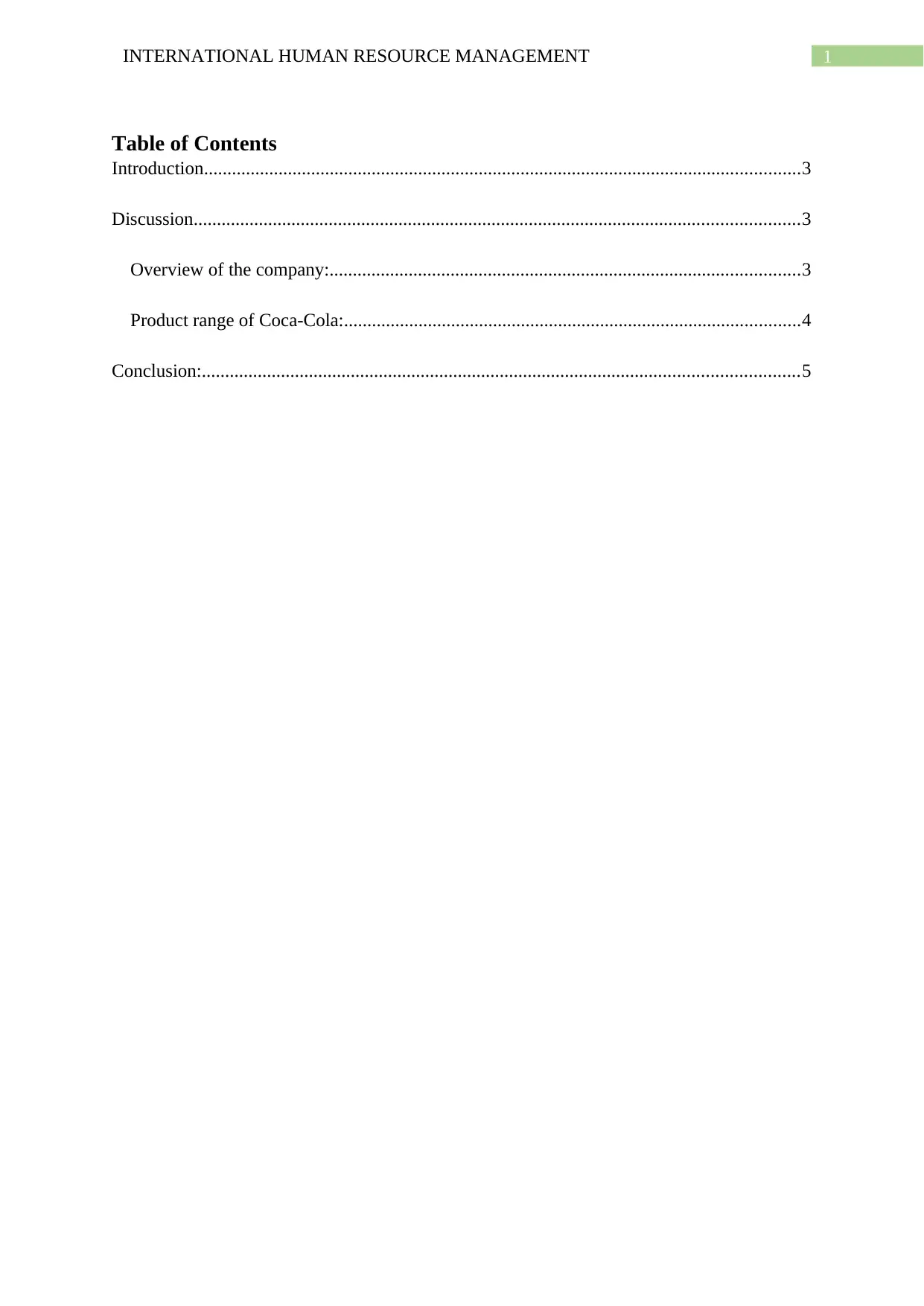
1INTERNATIONAL HUMAN RESOURCE MANAGEMENT
Table of Contents
Introduction................................................................................................................................3
Discussion..................................................................................................................................3
Overview of the company:.....................................................................................................3
Product range of Coca-Cola:..................................................................................................4
Conclusion:................................................................................................................................5
Table of Contents
Introduction................................................................................................................................3
Discussion..................................................................................................................................3
Overview of the company:.....................................................................................................3
Product range of Coca-Cola:..................................................................................................4
Conclusion:................................................................................................................................5
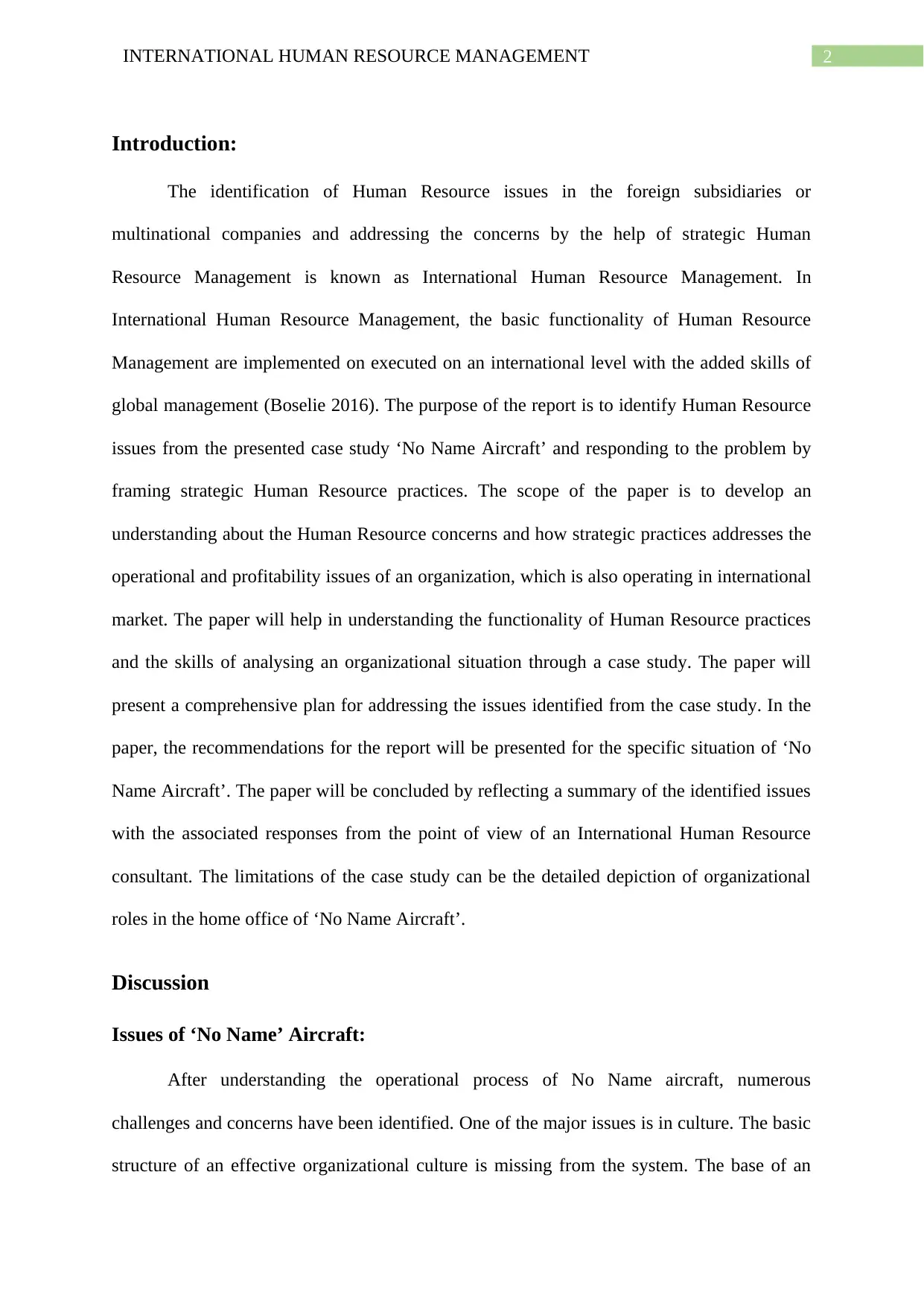
2INTERNATIONAL HUMAN RESOURCE MANAGEMENT
Introduction:
The identification of Human Resource issues in the foreign subsidiaries or
multinational companies and addressing the concerns by the help of strategic Human
Resource Management is known as International Human Resource Management. In
International Human Resource Management, the basic functionality of Human Resource
Management are implemented on executed on an international level with the added skills of
global management (Boselie 2016). The purpose of the report is to identify Human Resource
issues from the presented case study ‘No Name Aircraft’ and responding to the problem by
framing strategic Human Resource practices. The scope of the paper is to develop an
understanding about the Human Resource concerns and how strategic practices addresses the
operational and profitability issues of an organization, which is also operating in international
market. The paper will help in understanding the functionality of Human Resource practices
and the skills of analysing an organizational situation through a case study. The paper will
present a comprehensive plan for addressing the issues identified from the case study. In the
paper, the recommendations for the report will be presented for the specific situation of ‘No
Name Aircraft’. The paper will be concluded by reflecting a summary of the identified issues
with the associated responses from the point of view of an International Human Resource
consultant. The limitations of the case study can be the detailed depiction of organizational
roles in the home office of ‘No Name Aircraft’.
Discussion
Issues of ‘No Name’ Aircraft:
After understanding the operational process of No Name aircraft, numerous
challenges and concerns have been identified. One of the major issues is in culture. The basic
structure of an effective organizational culture is missing from the system. The base of an
Introduction:
The identification of Human Resource issues in the foreign subsidiaries or
multinational companies and addressing the concerns by the help of strategic Human
Resource Management is known as International Human Resource Management. In
International Human Resource Management, the basic functionality of Human Resource
Management are implemented on executed on an international level with the added skills of
global management (Boselie 2016). The purpose of the report is to identify Human Resource
issues from the presented case study ‘No Name Aircraft’ and responding to the problem by
framing strategic Human Resource practices. The scope of the paper is to develop an
understanding about the Human Resource concerns and how strategic practices addresses the
operational and profitability issues of an organization, which is also operating in international
market. The paper will help in understanding the functionality of Human Resource practices
and the skills of analysing an organizational situation through a case study. The paper will
present a comprehensive plan for addressing the issues identified from the case study. In the
paper, the recommendations for the report will be presented for the specific situation of ‘No
Name Aircraft’. The paper will be concluded by reflecting a summary of the identified issues
with the associated responses from the point of view of an International Human Resource
consultant. The limitations of the case study can be the detailed depiction of organizational
roles in the home office of ‘No Name Aircraft’.
Discussion
Issues of ‘No Name’ Aircraft:
After understanding the operational process of No Name aircraft, numerous
challenges and concerns have been identified. One of the major issues is in culture. The basic
structure of an effective organizational culture is missing from the system. The base of an
⊘ This is a preview!⊘
Do you want full access?
Subscribe today to unlock all pages.

Trusted by 1+ million students worldwide
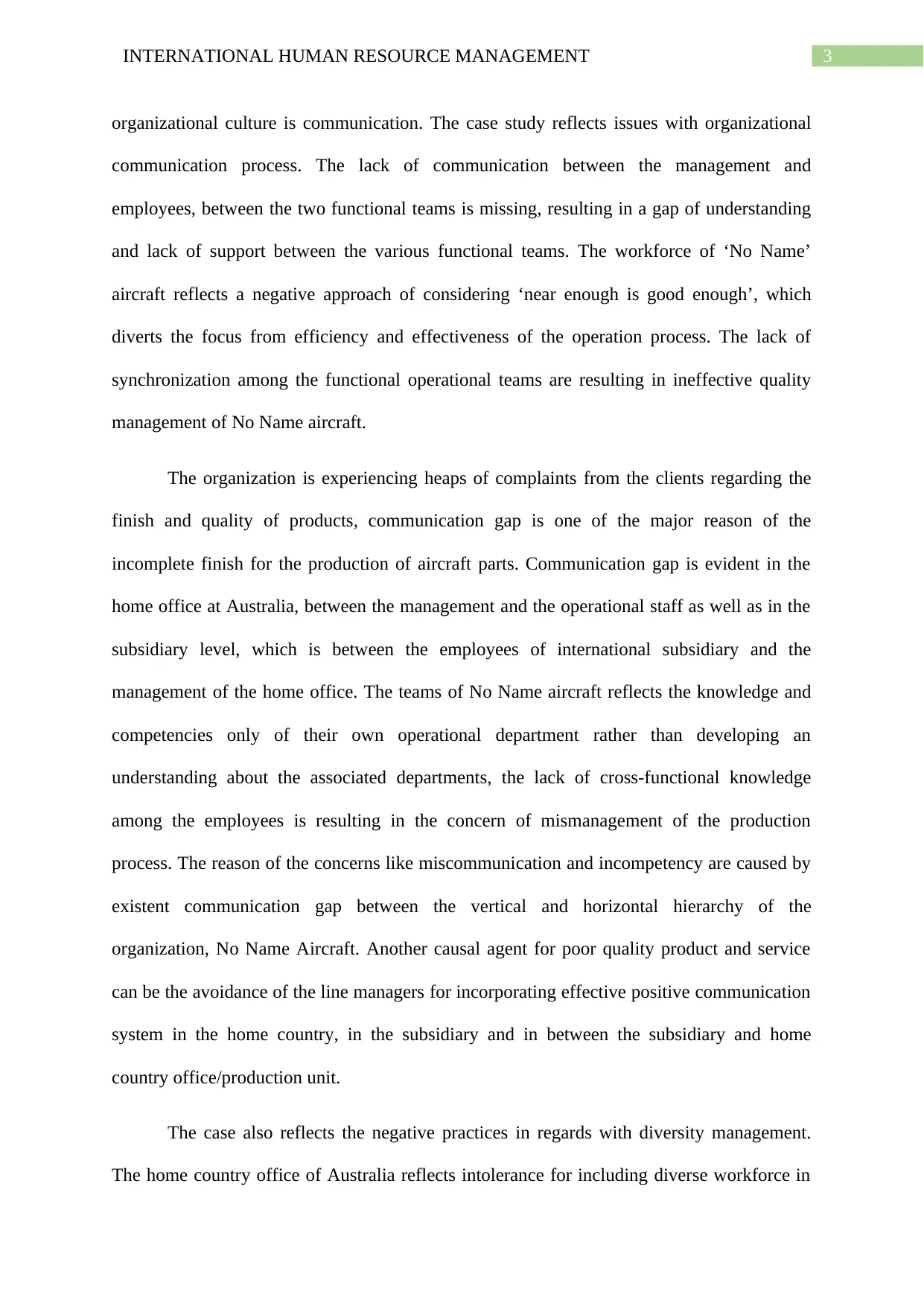
3INTERNATIONAL HUMAN RESOURCE MANAGEMENT
organizational culture is communication. The case study reflects issues with organizational
communication process. The lack of communication between the management and
employees, between the two functional teams is missing, resulting in a gap of understanding
and lack of support between the various functional teams. The workforce of ‘No Name’
aircraft reflects a negative approach of considering ‘near enough is good enough’, which
diverts the focus from efficiency and effectiveness of the operation process. The lack of
synchronization among the functional operational teams are resulting in ineffective quality
management of No Name aircraft.
The organization is experiencing heaps of complaints from the clients regarding the
finish and quality of products, communication gap is one of the major reason of the
incomplete finish for the production of aircraft parts. Communication gap is evident in the
home office at Australia, between the management and the operational staff as well as in the
subsidiary level, which is between the employees of international subsidiary and the
management of the home office. The teams of No Name aircraft reflects the knowledge and
competencies only of their own operational department rather than developing an
understanding about the associated departments, the lack of cross-functional knowledge
among the employees is resulting in the concern of mismanagement of the production
process. The reason of the concerns like miscommunication and incompetency are caused by
existent communication gap between the vertical and horizontal hierarchy of the
organization, No Name Aircraft. Another causal agent for poor quality product and service
can be the avoidance of the line managers for incorporating effective positive communication
system in the home country, in the subsidiary and in between the subsidiary and home
country office/production unit.
The case also reflects the negative practices in regards with diversity management.
The home country office of Australia reflects intolerance for including diverse workforce in
organizational culture is communication. The case study reflects issues with organizational
communication process. The lack of communication between the management and
employees, between the two functional teams is missing, resulting in a gap of understanding
and lack of support between the various functional teams. The workforce of ‘No Name’
aircraft reflects a negative approach of considering ‘near enough is good enough’, which
diverts the focus from efficiency and effectiveness of the operation process. The lack of
synchronization among the functional operational teams are resulting in ineffective quality
management of No Name aircraft.
The organization is experiencing heaps of complaints from the clients regarding the
finish and quality of products, communication gap is one of the major reason of the
incomplete finish for the production of aircraft parts. Communication gap is evident in the
home office at Australia, between the management and the operational staff as well as in the
subsidiary level, which is between the employees of international subsidiary and the
management of the home office. The teams of No Name aircraft reflects the knowledge and
competencies only of their own operational department rather than developing an
understanding about the associated departments, the lack of cross-functional knowledge
among the employees is resulting in the concern of mismanagement of the production
process. The reason of the concerns like miscommunication and incompetency are caused by
existent communication gap between the vertical and horizontal hierarchy of the
organization, No Name Aircraft. Another causal agent for poor quality product and service
can be the avoidance of the line managers for incorporating effective positive communication
system in the home country, in the subsidiary and in between the subsidiary and home
country office/production unit.
The case also reflects the negative practices in regards with diversity management.
The home country office of Australia reflects intolerance for including diverse workforce in
Paraphrase This Document
Need a fresh take? Get an instant paraphrase of this document with our AI Paraphraser
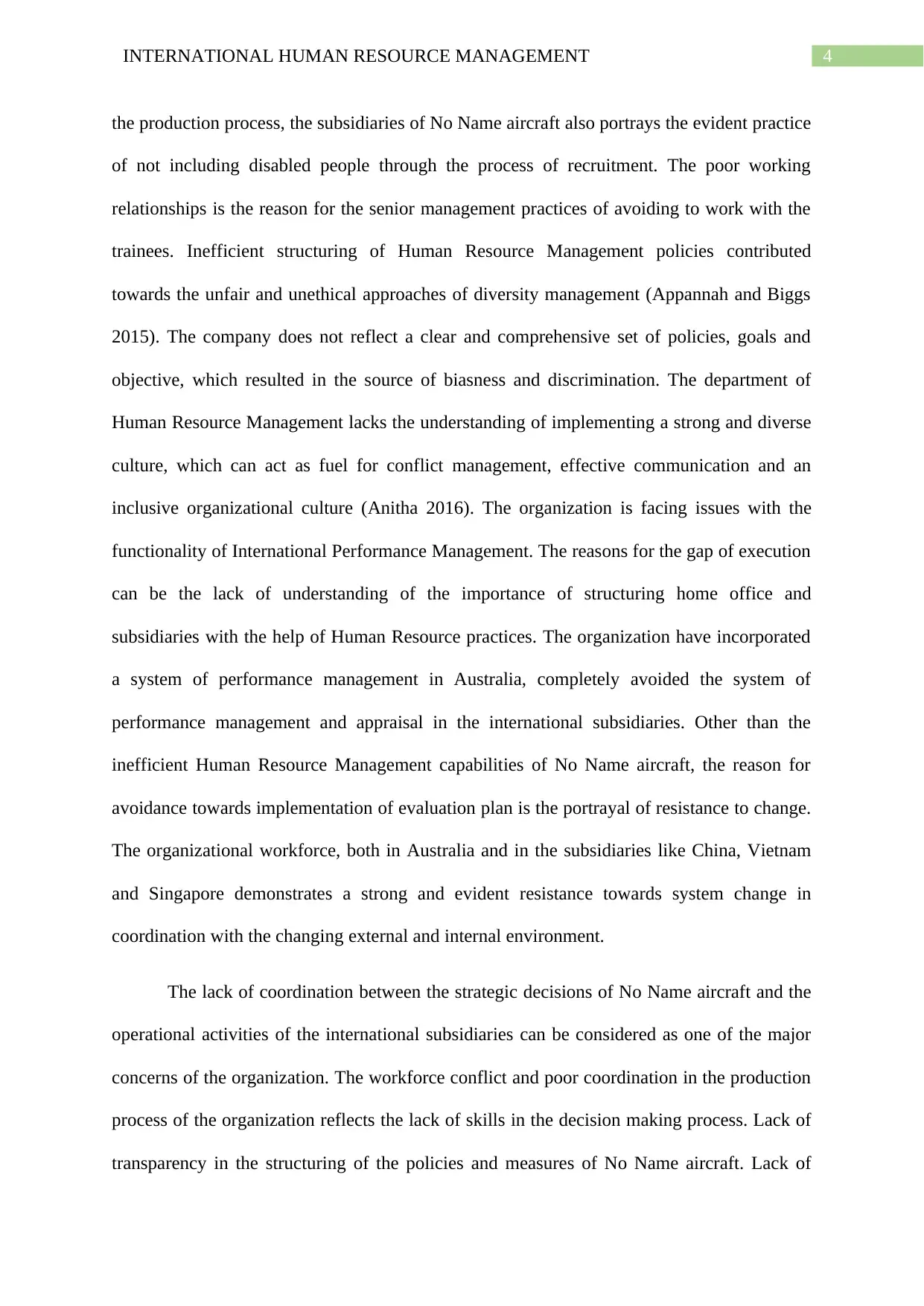
4INTERNATIONAL HUMAN RESOURCE MANAGEMENT
the production process, the subsidiaries of No Name aircraft also portrays the evident practice
of not including disabled people through the process of recruitment. The poor working
relationships is the reason for the senior management practices of avoiding to work with the
trainees. Inefficient structuring of Human Resource Management policies contributed
towards the unfair and unethical approaches of diversity management (Appannah and Biggs
2015). The company does not reflect a clear and comprehensive set of policies, goals and
objective, which resulted in the source of biasness and discrimination. The department of
Human Resource Management lacks the understanding of implementing a strong and diverse
culture, which can act as fuel for conflict management, effective communication and an
inclusive organizational culture (Anitha 2016). The organization is facing issues with the
functionality of International Performance Management. The reasons for the gap of execution
can be the lack of understanding of the importance of structuring home office and
subsidiaries with the help of Human Resource practices. The organization have incorporated
a system of performance management in Australia, completely avoided the system of
performance management and appraisal in the international subsidiaries. Other than the
inefficient Human Resource Management capabilities of No Name aircraft, the reason for
avoidance towards implementation of evaluation plan is the portrayal of resistance to change.
The organizational workforce, both in Australia and in the subsidiaries like China, Vietnam
and Singapore demonstrates a strong and evident resistance towards system change in
coordination with the changing external and internal environment.
The lack of coordination between the strategic decisions of No Name aircraft and the
operational activities of the international subsidiaries can be considered as one of the major
concerns of the organization. The workforce conflict and poor coordination in the production
process of the organization reflects the lack of skills in the decision making process. Lack of
transparency in the structuring of the policies and measures of No Name aircraft. Lack of
the production process, the subsidiaries of No Name aircraft also portrays the evident practice
of not including disabled people through the process of recruitment. The poor working
relationships is the reason for the senior management practices of avoiding to work with the
trainees. Inefficient structuring of Human Resource Management policies contributed
towards the unfair and unethical approaches of diversity management (Appannah and Biggs
2015). The company does not reflect a clear and comprehensive set of policies, goals and
objective, which resulted in the source of biasness and discrimination. The department of
Human Resource Management lacks the understanding of implementing a strong and diverse
culture, which can act as fuel for conflict management, effective communication and an
inclusive organizational culture (Anitha 2016). The organization is facing issues with the
functionality of International Performance Management. The reasons for the gap of execution
can be the lack of understanding of the importance of structuring home office and
subsidiaries with the help of Human Resource practices. The organization have incorporated
a system of performance management in Australia, completely avoided the system of
performance management and appraisal in the international subsidiaries. Other than the
inefficient Human Resource Management capabilities of No Name aircraft, the reason for
avoidance towards implementation of evaluation plan is the portrayal of resistance to change.
The organizational workforce, both in Australia and in the subsidiaries like China, Vietnam
and Singapore demonstrates a strong and evident resistance towards system change in
coordination with the changing external and internal environment.
The lack of coordination between the strategic decisions of No Name aircraft and the
operational activities of the international subsidiaries can be considered as one of the major
concerns of the organization. The workforce conflict and poor coordination in the production
process of the organization reflects the lack of skills in the decision making process. Lack of
transparency in the structuring of the policies and measures of No Name aircraft. Lack of
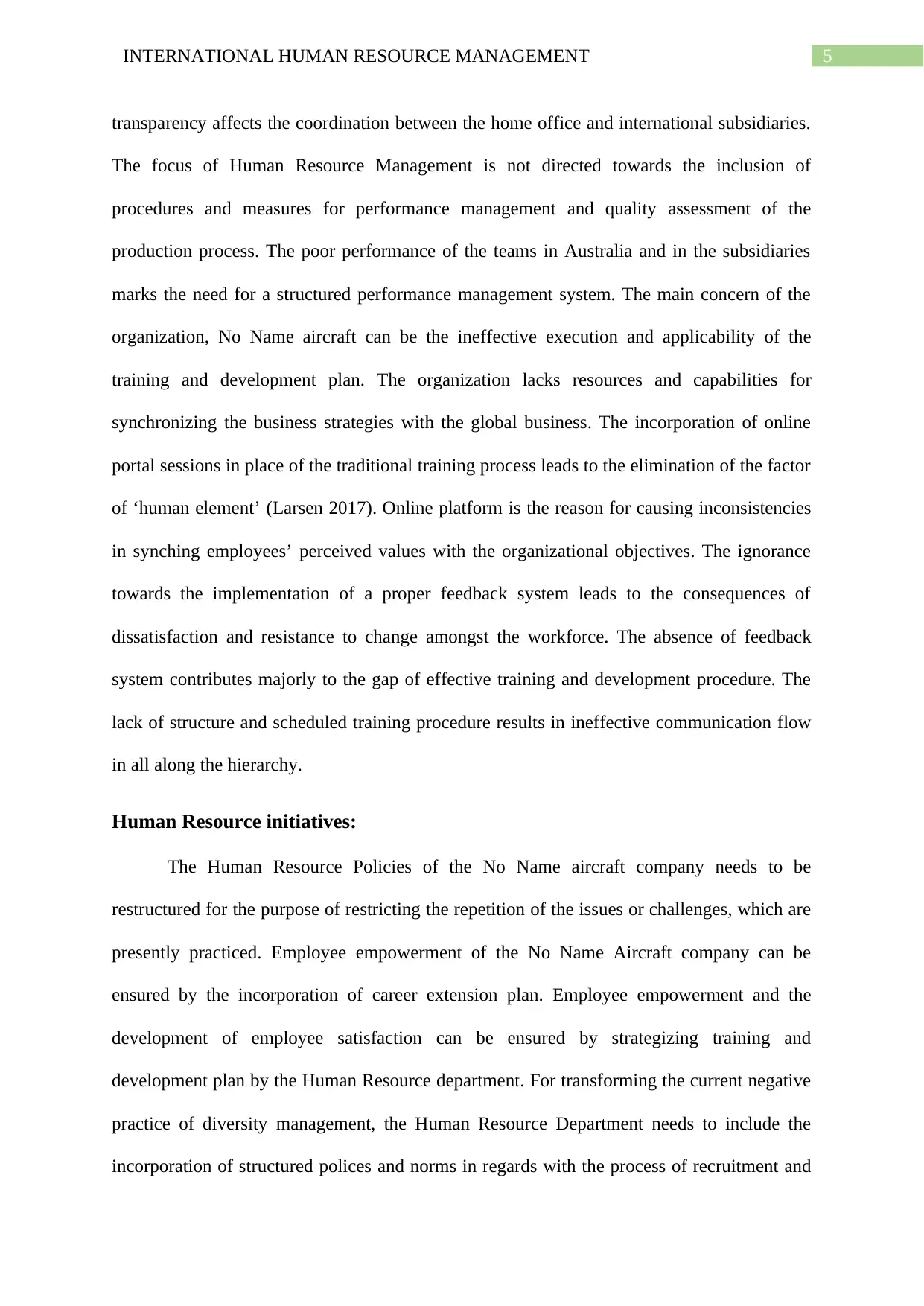
5INTERNATIONAL HUMAN RESOURCE MANAGEMENT
transparency affects the coordination between the home office and international subsidiaries.
The focus of Human Resource Management is not directed towards the inclusion of
procedures and measures for performance management and quality assessment of the
production process. The poor performance of the teams in Australia and in the subsidiaries
marks the need for a structured performance management system. The main concern of the
organization, No Name aircraft can be the ineffective execution and applicability of the
training and development plan. The organization lacks resources and capabilities for
synchronizing the business strategies with the global business. The incorporation of online
portal sessions in place of the traditional training process leads to the elimination of the factor
of ‘human element’ (Larsen 2017). Online platform is the reason for causing inconsistencies
in synching employees’ perceived values with the organizational objectives. The ignorance
towards the implementation of a proper feedback system leads to the consequences of
dissatisfaction and resistance to change amongst the workforce. The absence of feedback
system contributes majorly to the gap of effective training and development procedure. The
lack of structure and scheduled training procedure results in ineffective communication flow
in all along the hierarchy.
Human Resource initiatives:
The Human Resource Policies of the No Name aircraft company needs to be
restructured for the purpose of restricting the repetition of the issues or challenges, which are
presently practiced. Employee empowerment of the No Name Aircraft company can be
ensured by the incorporation of career extension plan. Employee empowerment and the
development of employee satisfaction can be ensured by strategizing training and
development plan by the Human Resource department. For transforming the current negative
practice of diversity management, the Human Resource Department needs to include the
incorporation of structured polices and norms in regards with the process of recruitment and
transparency affects the coordination between the home office and international subsidiaries.
The focus of Human Resource Management is not directed towards the inclusion of
procedures and measures for performance management and quality assessment of the
production process. The poor performance of the teams in Australia and in the subsidiaries
marks the need for a structured performance management system. The main concern of the
organization, No Name aircraft can be the ineffective execution and applicability of the
training and development plan. The organization lacks resources and capabilities for
synchronizing the business strategies with the global business. The incorporation of online
portal sessions in place of the traditional training process leads to the elimination of the factor
of ‘human element’ (Larsen 2017). Online platform is the reason for causing inconsistencies
in synching employees’ perceived values with the organizational objectives. The ignorance
towards the implementation of a proper feedback system leads to the consequences of
dissatisfaction and resistance to change amongst the workforce. The absence of feedback
system contributes majorly to the gap of effective training and development procedure. The
lack of structure and scheduled training procedure results in ineffective communication flow
in all along the hierarchy.
Human Resource initiatives:
The Human Resource Policies of the No Name aircraft company needs to be
restructured for the purpose of restricting the repetition of the issues or challenges, which are
presently practiced. Employee empowerment of the No Name Aircraft company can be
ensured by the incorporation of career extension plan. Employee empowerment and the
development of employee satisfaction can be ensured by strategizing training and
development plan by the Human Resource department. For transforming the current negative
practice of diversity management, the Human Resource Department needs to include the
incorporation of structured polices and norms in regards with the process of recruitment and
⊘ This is a preview!⊘
Do you want full access?
Subscribe today to unlock all pages.

Trusted by 1+ million students worldwide
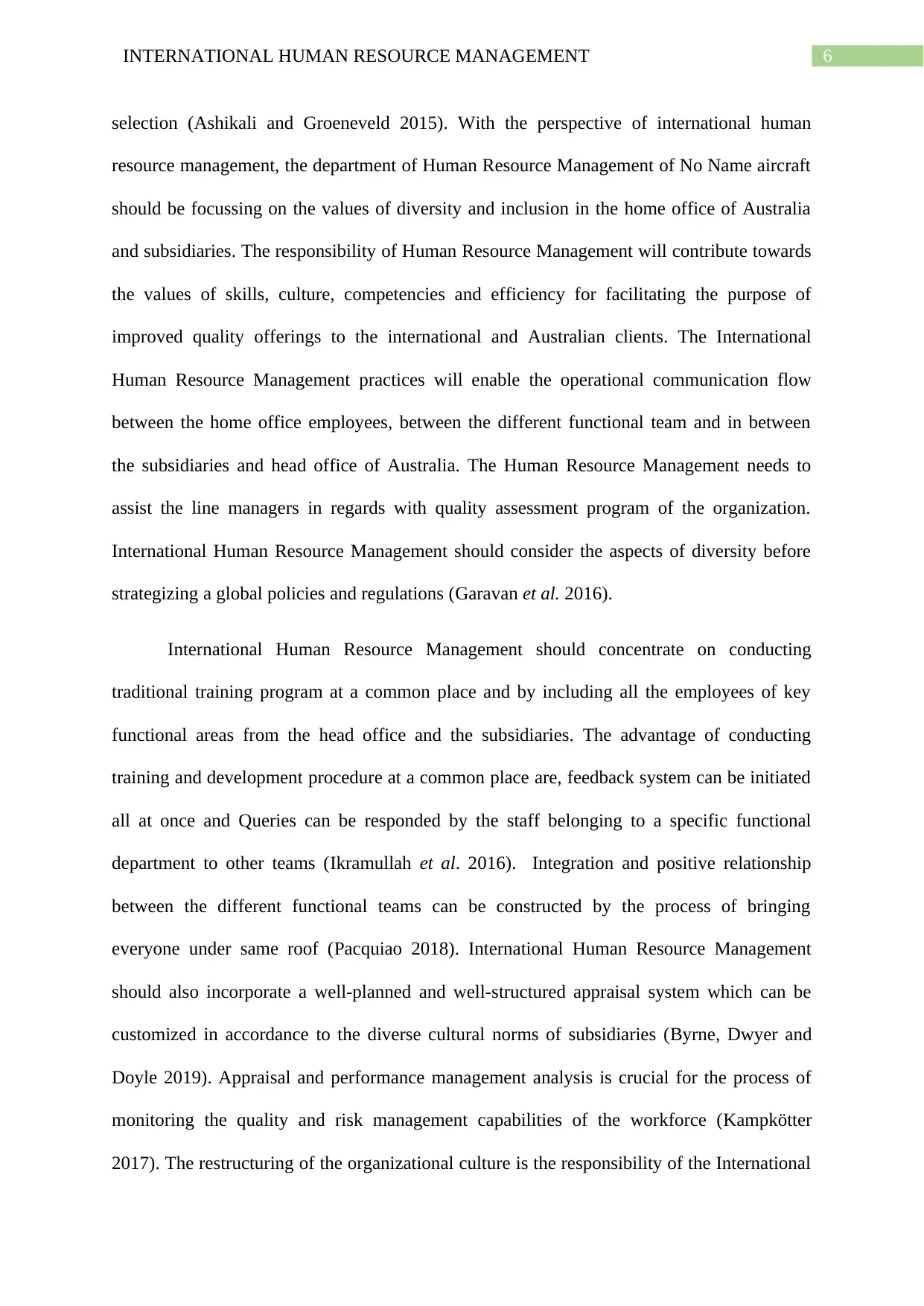
6INTERNATIONAL HUMAN RESOURCE MANAGEMENT
selection (Ashikali and Groeneveld 2015). With the perspective of international human
resource management, the department of Human Resource Management of No Name aircraft
should be focussing on the values of diversity and inclusion in the home office of Australia
and subsidiaries. The responsibility of Human Resource Management will contribute towards
the values of skills, culture, competencies and efficiency for facilitating the purpose of
improved quality offerings to the international and Australian clients. The International
Human Resource Management practices will enable the operational communication flow
between the home office employees, between the different functional team and in between
the subsidiaries and head office of Australia. The Human Resource Management needs to
assist the line managers in regards with quality assessment program of the organization.
International Human Resource Management should consider the aspects of diversity before
strategizing a global policies and regulations (Garavan et al. 2016).
International Human Resource Management should concentrate on conducting
traditional training program at a common place and by including all the employees of key
functional areas from the head office and the subsidiaries. The advantage of conducting
training and development procedure at a common place are, feedback system can be initiated
all at once and Queries can be responded by the staff belonging to a specific functional
department to other teams (Ikramullah et al. 2016). Integration and positive relationship
between the different functional teams can be constructed by the process of bringing
everyone under same roof (Pacquiao 2018). International Human Resource Management
should also incorporate a well-planned and well-structured appraisal system which can be
customized in accordance to the diverse cultural norms of subsidiaries (Byrne, Dwyer and
Doyle 2019). Appraisal and performance management analysis is crucial for the process of
monitoring the quality and risk management capabilities of the workforce (Kampkötter
2017). The restructuring of the organizational culture is the responsibility of the International
selection (Ashikali and Groeneveld 2015). With the perspective of international human
resource management, the department of Human Resource Management of No Name aircraft
should be focussing on the values of diversity and inclusion in the home office of Australia
and subsidiaries. The responsibility of Human Resource Management will contribute towards
the values of skills, culture, competencies and efficiency for facilitating the purpose of
improved quality offerings to the international and Australian clients. The International
Human Resource Management practices will enable the operational communication flow
between the home office employees, between the different functional team and in between
the subsidiaries and head office of Australia. The Human Resource Management needs to
assist the line managers in regards with quality assessment program of the organization.
International Human Resource Management should consider the aspects of diversity before
strategizing a global policies and regulations (Garavan et al. 2016).
International Human Resource Management should concentrate on conducting
traditional training program at a common place and by including all the employees of key
functional areas from the head office and the subsidiaries. The advantage of conducting
training and development procedure at a common place are, feedback system can be initiated
all at once and Queries can be responded by the staff belonging to a specific functional
department to other teams (Ikramullah et al. 2016). Integration and positive relationship
between the different functional teams can be constructed by the process of bringing
everyone under same roof (Pacquiao 2018). International Human Resource Management
should also incorporate a well-planned and well-structured appraisal system which can be
customized in accordance to the diverse cultural norms of subsidiaries (Byrne, Dwyer and
Doyle 2019). Appraisal and performance management analysis is crucial for the process of
monitoring the quality and risk management capabilities of the workforce (Kampkötter
2017). The restructuring of the organizational culture is the responsibility of the International
Paraphrase This Document
Need a fresh take? Get an instant paraphrase of this document with our AI Paraphraser

7INTERNATIONAL HUMAN RESOURCE MANAGEMENT
Human Resource Management, which can result in a situation of trust and flexibility
(Kampkötter 2017). International Human Resource Management should also concentrate on
the factor of introducing harmony in workplace through the process of building newer
opportunities.
International Human Resource Management Plan:
The International Human Resource Plan can be strategized and implemented by following the
structure of Human Resource Planning and Analysis Model. The Human Resource Plan will
include the process of Gap analysis by assessing the existing state of the skills and
competencies, by restructuring the values and vision of the No Name Aircraft company. The
Gap analysis will also cover the incorporation of a strategic human resource management
plan, which can effectively address the issues and concerns of the workforce. Through the
medium of Gap analysis, the causes of the concerns and challenges can be identified. The gap
analysis will determine the managerial inefficiency in implementing effective communication
flow, the gap in the execution of policy alignment as well as in the process of structuring
policies with the consideration of diverse culture and internationalization. After conducting
the gap analysis, the International Human Resource Management competencies will be
incorporated (Garg, Pandey and Vashishta 2017). The work design will have to be
restructured based on the policy of effective communication flow and integration of
functional departments on the basis of knowledge development. The recruitment and
selection plan of the organization, No Name Aircraft will be established on the basis of the
need of inclusion policies. The inclusion policies in the recruitment and selection process in
the home office of Australia and in the subsidiaries will address the issues regarding diversity
management (Elsmore 2017). Diversity management will ensure the inclusion of skilled
workforce without the restriction of social background or physical disabilities. International
Human Resource Management reflects the responsibility of implementing a single inclusion
Human Resource Management, which can result in a situation of trust and flexibility
(Kampkötter 2017). International Human Resource Management should also concentrate on
the factor of introducing harmony in workplace through the process of building newer
opportunities.
International Human Resource Management Plan:
The International Human Resource Plan can be strategized and implemented by following the
structure of Human Resource Planning and Analysis Model. The Human Resource Plan will
include the process of Gap analysis by assessing the existing state of the skills and
competencies, by restructuring the values and vision of the No Name Aircraft company. The
Gap analysis will also cover the incorporation of a strategic human resource management
plan, which can effectively address the issues and concerns of the workforce. Through the
medium of Gap analysis, the causes of the concerns and challenges can be identified. The gap
analysis will determine the managerial inefficiency in implementing effective communication
flow, the gap in the execution of policy alignment as well as in the process of structuring
policies with the consideration of diverse culture and internationalization. After conducting
the gap analysis, the International Human Resource Management competencies will be
incorporated (Garg, Pandey and Vashishta 2017). The work design will have to be
restructured based on the policy of effective communication flow and integration of
functional departments on the basis of knowledge development. The recruitment and
selection plan of the organization, No Name Aircraft will be established on the basis of the
need of inclusion policies. The inclusion policies in the recruitment and selection process in
the home office of Australia and in the subsidiaries will address the issues regarding diversity
management (Elsmore 2017). Diversity management will ensure the inclusion of skilled
workforce without the restriction of social background or physical disabilities. International
Human Resource Management reflects the responsibility of implementing a single inclusion
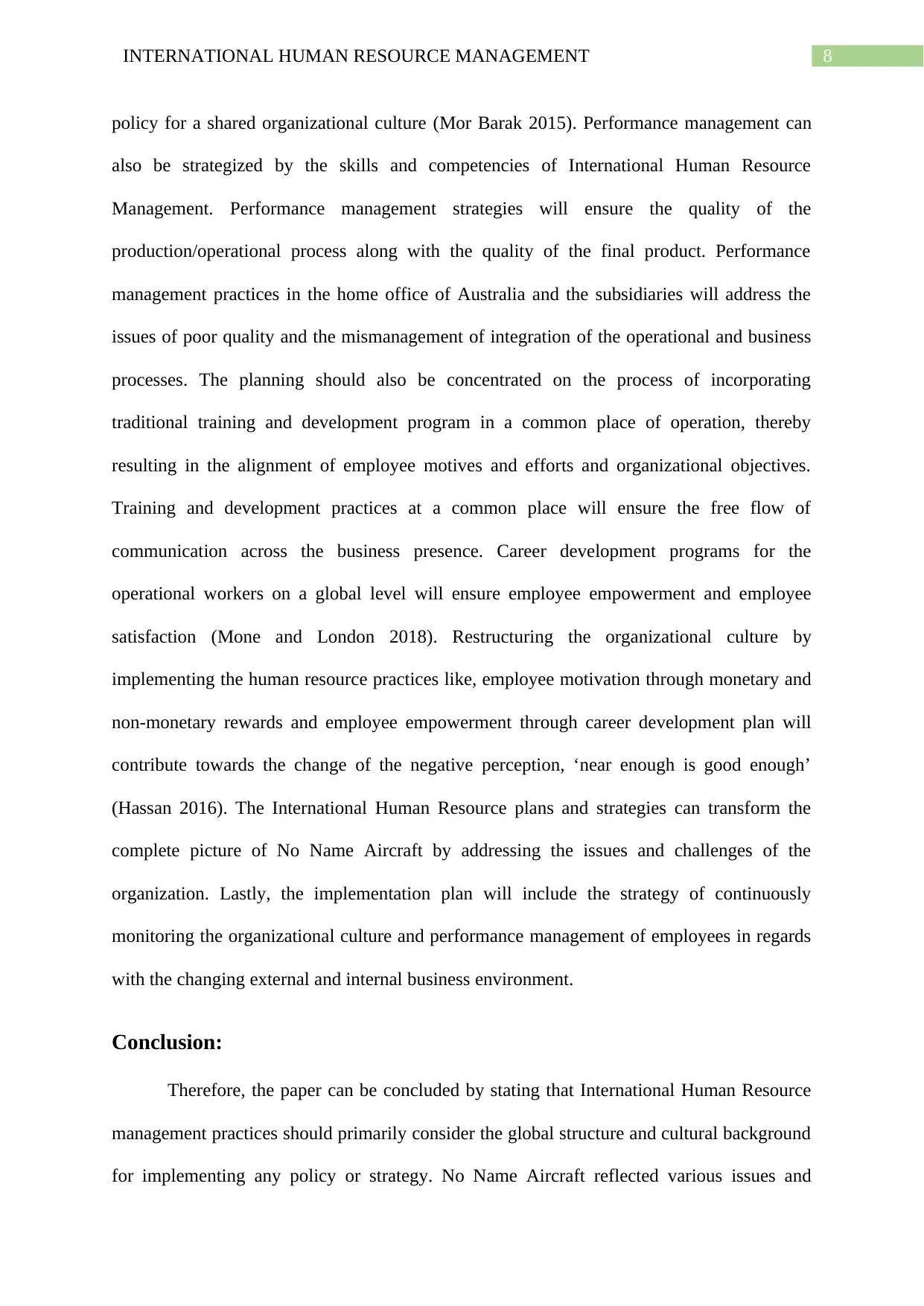
8INTERNATIONAL HUMAN RESOURCE MANAGEMENT
policy for a shared organizational culture (Mor Barak 2015). Performance management can
also be strategized by the skills and competencies of International Human Resource
Management. Performance management strategies will ensure the quality of the
production/operational process along with the quality of the final product. Performance
management practices in the home office of Australia and the subsidiaries will address the
issues of poor quality and the mismanagement of integration of the operational and business
processes. The planning should also be concentrated on the process of incorporating
traditional training and development program in a common place of operation, thereby
resulting in the alignment of employee motives and efforts and organizational objectives.
Training and development practices at a common place will ensure the free flow of
communication across the business presence. Career development programs for the
operational workers on a global level will ensure employee empowerment and employee
satisfaction (Mone and London 2018). Restructuring the organizational culture by
implementing the human resource practices like, employee motivation through monetary and
non-monetary rewards and employee empowerment through career development plan will
contribute towards the change of the negative perception, ‘near enough is good enough’
(Hassan 2016). The International Human Resource plans and strategies can transform the
complete picture of No Name Aircraft by addressing the issues and challenges of the
organization. Lastly, the implementation plan will include the strategy of continuously
monitoring the organizational culture and performance management of employees in regards
with the changing external and internal business environment.
Conclusion:
Therefore, the paper can be concluded by stating that International Human Resource
management practices should primarily consider the global structure and cultural background
for implementing any policy or strategy. No Name Aircraft reflected various issues and
policy for a shared organizational culture (Mor Barak 2015). Performance management can
also be strategized by the skills and competencies of International Human Resource
Management. Performance management strategies will ensure the quality of the
production/operational process along with the quality of the final product. Performance
management practices in the home office of Australia and the subsidiaries will address the
issues of poor quality and the mismanagement of integration of the operational and business
processes. The planning should also be concentrated on the process of incorporating
traditional training and development program in a common place of operation, thereby
resulting in the alignment of employee motives and efforts and organizational objectives.
Training and development practices at a common place will ensure the free flow of
communication across the business presence. Career development programs for the
operational workers on a global level will ensure employee empowerment and employee
satisfaction (Mone and London 2018). Restructuring the organizational culture by
implementing the human resource practices like, employee motivation through monetary and
non-monetary rewards and employee empowerment through career development plan will
contribute towards the change of the negative perception, ‘near enough is good enough’
(Hassan 2016). The International Human Resource plans and strategies can transform the
complete picture of No Name Aircraft by addressing the issues and challenges of the
organization. Lastly, the implementation plan will include the strategy of continuously
monitoring the organizational culture and performance management of employees in regards
with the changing external and internal business environment.
Conclusion:
Therefore, the paper can be concluded by stating that International Human Resource
management practices should primarily consider the global structure and cultural background
for implementing any policy or strategy. No Name Aircraft reflected various issues and
⊘ This is a preview!⊘
Do you want full access?
Subscribe today to unlock all pages.

Trusted by 1+ million students worldwide
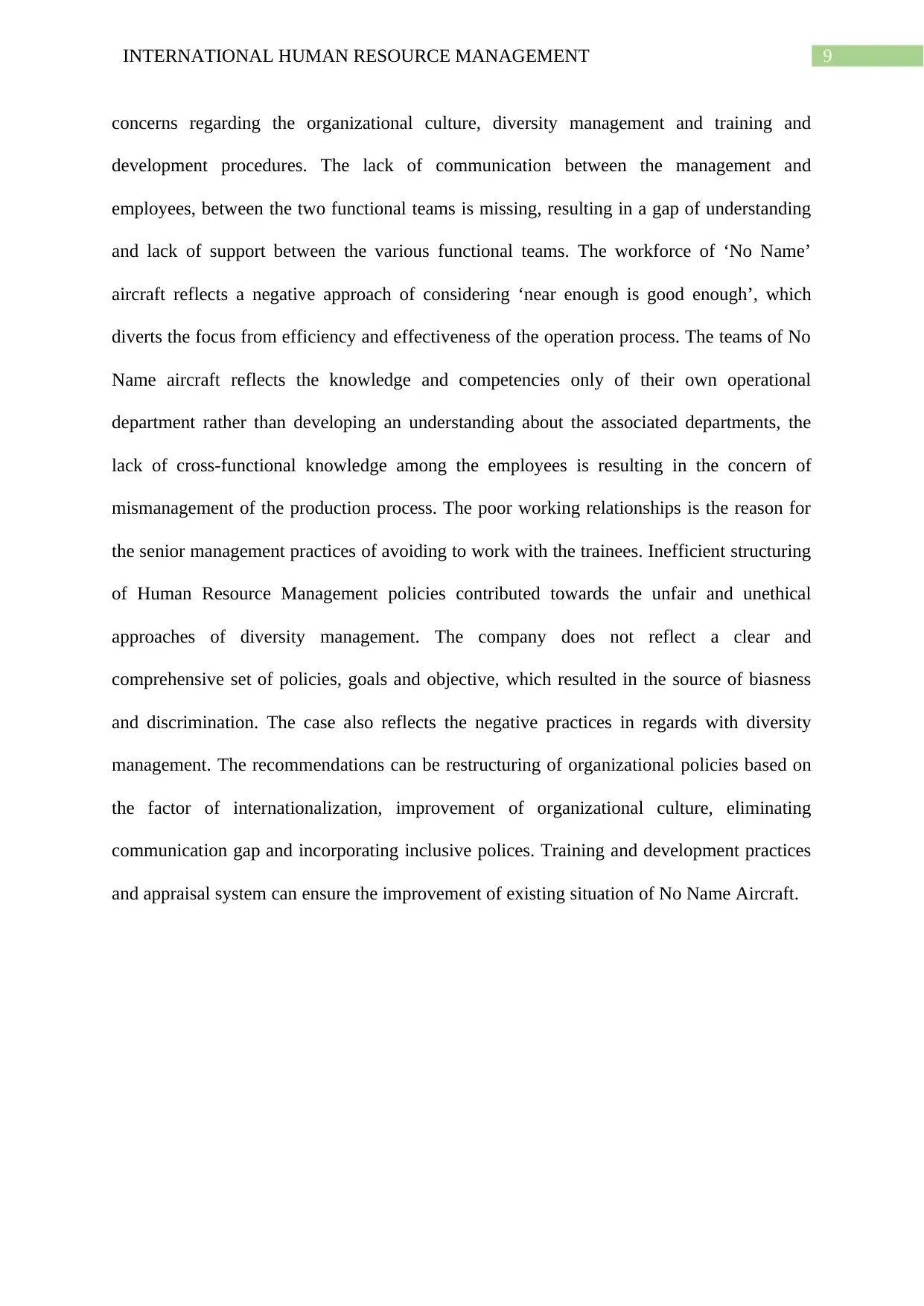
9INTERNATIONAL HUMAN RESOURCE MANAGEMENT
concerns regarding the organizational culture, diversity management and training and
development procedures. The lack of communication between the management and
employees, between the two functional teams is missing, resulting in a gap of understanding
and lack of support between the various functional teams. The workforce of ‘No Name’
aircraft reflects a negative approach of considering ‘near enough is good enough’, which
diverts the focus from efficiency and effectiveness of the operation process. The teams of No
Name aircraft reflects the knowledge and competencies only of their own operational
department rather than developing an understanding about the associated departments, the
lack of cross-functional knowledge among the employees is resulting in the concern of
mismanagement of the production process. The poor working relationships is the reason for
the senior management practices of avoiding to work with the trainees. Inefficient structuring
of Human Resource Management policies contributed towards the unfair and unethical
approaches of diversity management. The company does not reflect a clear and
comprehensive set of policies, goals and objective, which resulted in the source of biasness
and discrimination. The case also reflects the negative practices in regards with diversity
management. The recommendations can be restructuring of organizational policies based on
the factor of internationalization, improvement of organizational culture, eliminating
communication gap and incorporating inclusive polices. Training and development practices
and appraisal system can ensure the improvement of existing situation of No Name Aircraft.
concerns regarding the organizational culture, diversity management and training and
development procedures. The lack of communication between the management and
employees, between the two functional teams is missing, resulting in a gap of understanding
and lack of support between the various functional teams. The workforce of ‘No Name’
aircraft reflects a negative approach of considering ‘near enough is good enough’, which
diverts the focus from efficiency and effectiveness of the operation process. The teams of No
Name aircraft reflects the knowledge and competencies only of their own operational
department rather than developing an understanding about the associated departments, the
lack of cross-functional knowledge among the employees is resulting in the concern of
mismanagement of the production process. The poor working relationships is the reason for
the senior management practices of avoiding to work with the trainees. Inefficient structuring
of Human Resource Management policies contributed towards the unfair and unethical
approaches of diversity management. The company does not reflect a clear and
comprehensive set of policies, goals and objective, which resulted in the source of biasness
and discrimination. The case also reflects the negative practices in regards with diversity
management. The recommendations can be restructuring of organizational policies based on
the factor of internationalization, improvement of organizational culture, eliminating
communication gap and incorporating inclusive polices. Training and development practices
and appraisal system can ensure the improvement of existing situation of No Name Aircraft.
Paraphrase This Document
Need a fresh take? Get an instant paraphrase of this document with our AI Paraphraser
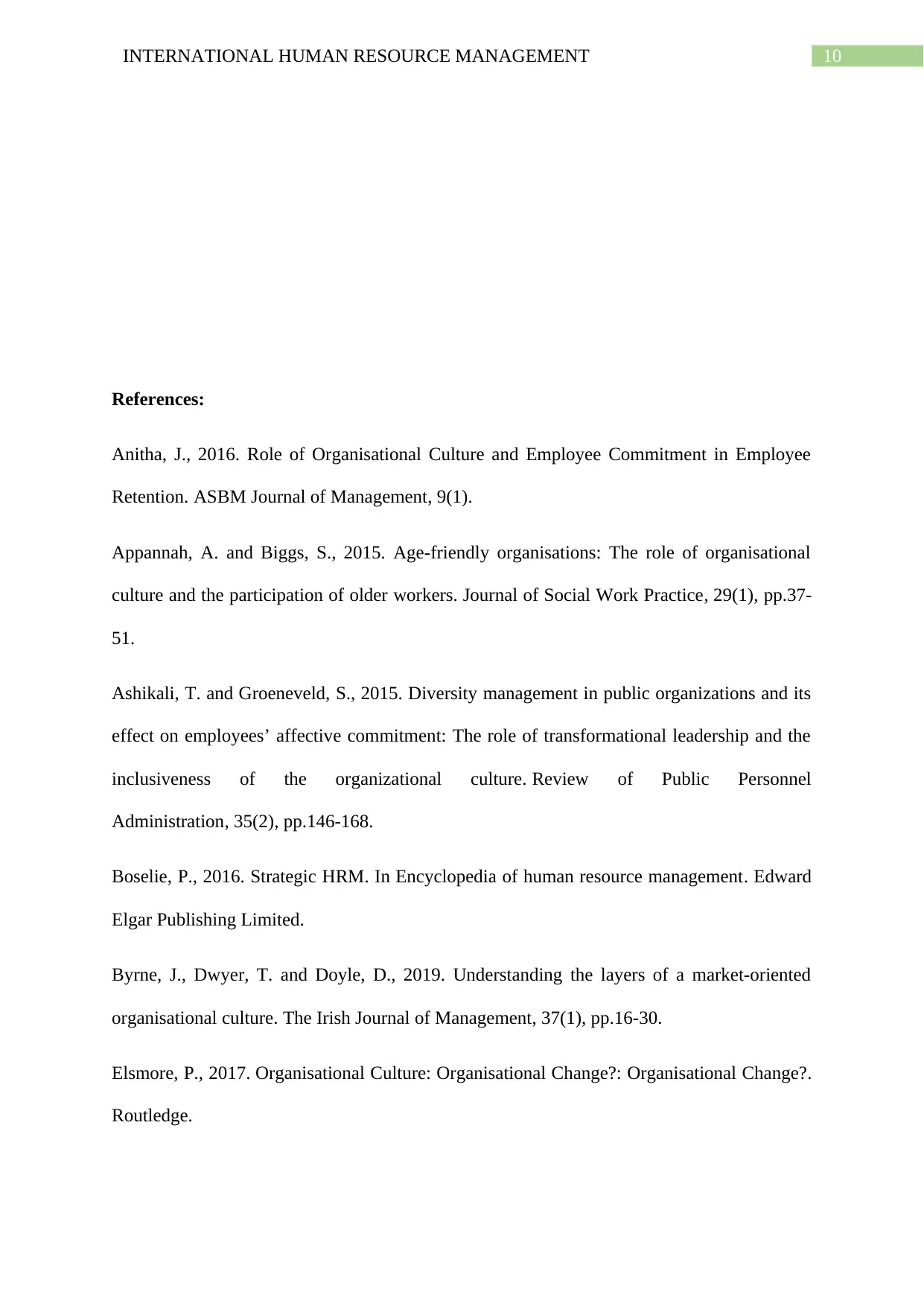
10INTERNATIONAL HUMAN RESOURCE MANAGEMENT
References:
Anitha, J., 2016. Role of Organisational Culture and Employee Commitment in Employee
Retention. ASBM Journal of Management, 9(1).
Appannah, A. and Biggs, S., 2015. Age-friendly organisations: The role of organisational
culture and the participation of older workers. Journal of Social Work Practice, 29(1), pp.37-
51.
Ashikali, T. and Groeneveld, S., 2015. Diversity management in public organizations and its
effect on employees’ affective commitment: The role of transformational leadership and the
inclusiveness of the organizational culture. Review of Public Personnel
Administration, 35(2), pp.146-168.
Boselie, P., 2016. Strategic HRM. In Encyclopedia of human resource management. Edward
Elgar Publishing Limited.
Byrne, J., Dwyer, T. and Doyle, D., 2019. Understanding the layers of a market-oriented
organisational culture. The Irish Journal of Management, 37(1), pp.16-30.
Elsmore, P., 2017. Organisational Culture: Organisational Change?: Organisational Change?.
Routledge.
References:
Anitha, J., 2016. Role of Organisational Culture and Employee Commitment in Employee
Retention. ASBM Journal of Management, 9(1).
Appannah, A. and Biggs, S., 2015. Age-friendly organisations: The role of organisational
culture and the participation of older workers. Journal of Social Work Practice, 29(1), pp.37-
51.
Ashikali, T. and Groeneveld, S., 2015. Diversity management in public organizations and its
effect on employees’ affective commitment: The role of transformational leadership and the
inclusiveness of the organizational culture. Review of Public Personnel
Administration, 35(2), pp.146-168.
Boselie, P., 2016. Strategic HRM. In Encyclopedia of human resource management. Edward
Elgar Publishing Limited.
Byrne, J., Dwyer, T. and Doyle, D., 2019. Understanding the layers of a market-oriented
organisational culture. The Irish Journal of Management, 37(1), pp.16-30.
Elsmore, P., 2017. Organisational Culture: Organisational Change?: Organisational Change?.
Routledge.
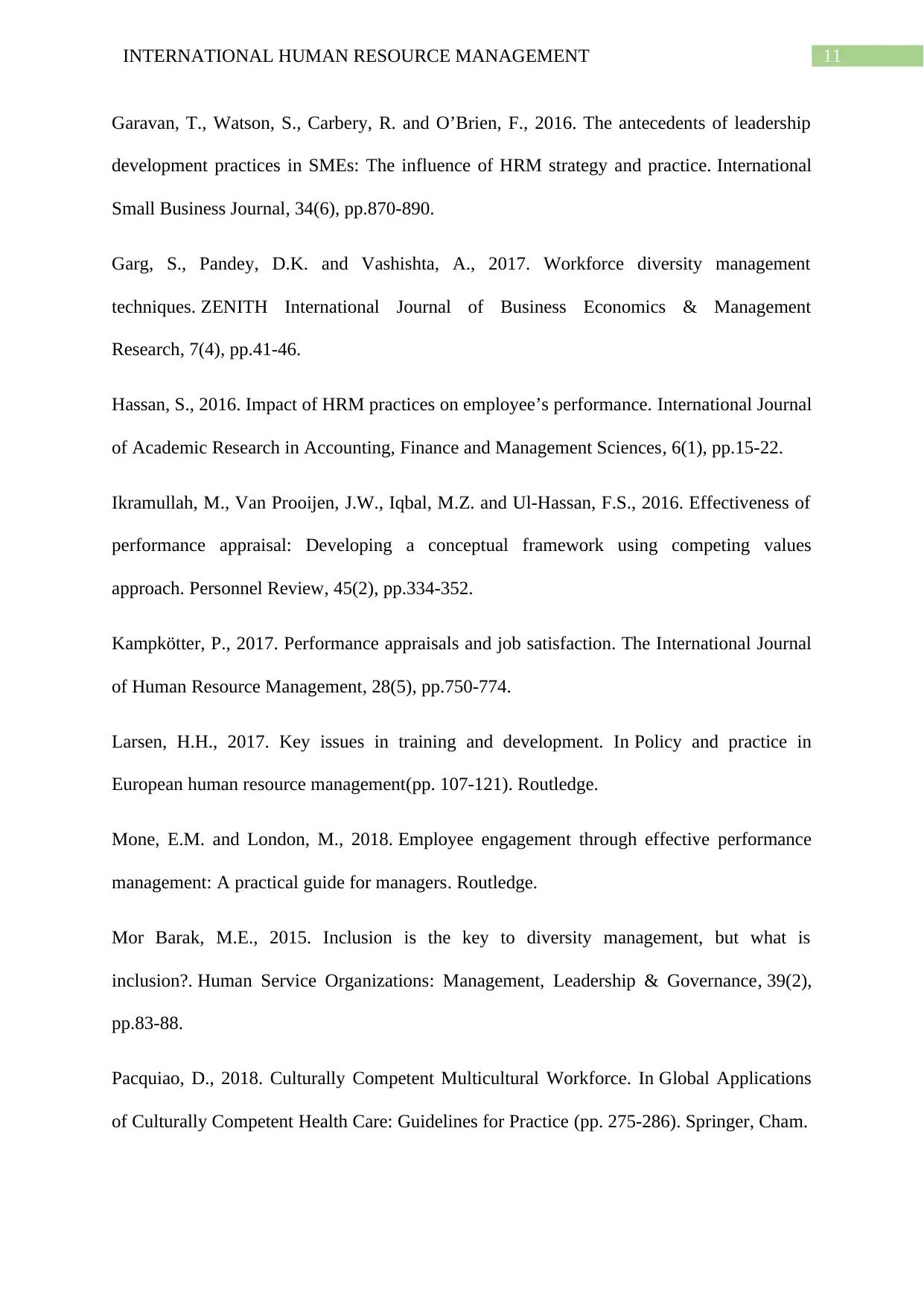
11INTERNATIONAL HUMAN RESOURCE MANAGEMENT
Garavan, T., Watson, S., Carbery, R. and O’Brien, F., 2016. The antecedents of leadership
development practices in SMEs: The influence of HRM strategy and practice. International
Small Business Journal, 34(6), pp.870-890.
Garg, S., Pandey, D.K. and Vashishta, A., 2017. Workforce diversity management
techniques. ZENITH International Journal of Business Economics & Management
Research, 7(4), pp.41-46.
Hassan, S., 2016. Impact of HRM practices on employee’s performance. International Journal
of Academic Research in Accounting, Finance and Management Sciences, 6(1), pp.15-22.
Ikramullah, M., Van Prooijen, J.W., Iqbal, M.Z. and Ul-Hassan, F.S., 2016. Effectiveness of
performance appraisal: Developing a conceptual framework using competing values
approach. Personnel Review, 45(2), pp.334-352.
Kampkötter, P., 2017. Performance appraisals and job satisfaction. The International Journal
of Human Resource Management, 28(5), pp.750-774.
Larsen, H.H., 2017. Key issues in training and development. In Policy and practice in
European human resource management(pp. 107-121). Routledge.
Mone, E.M. and London, M., 2018. Employee engagement through effective performance
management: A practical guide for managers. Routledge.
Mor Barak, M.E., 2015. Inclusion is the key to diversity management, but what is
inclusion?. Human Service Organizations: Management, Leadership & Governance, 39(2),
pp.83-88.
Pacquiao, D., 2018. Culturally Competent Multicultural Workforce. In Global Applications
of Culturally Competent Health Care: Guidelines for Practice (pp. 275-286). Springer, Cham.
Garavan, T., Watson, S., Carbery, R. and O’Brien, F., 2016. The antecedents of leadership
development practices in SMEs: The influence of HRM strategy and practice. International
Small Business Journal, 34(6), pp.870-890.
Garg, S., Pandey, D.K. and Vashishta, A., 2017. Workforce diversity management
techniques. ZENITH International Journal of Business Economics & Management
Research, 7(4), pp.41-46.
Hassan, S., 2016. Impact of HRM practices on employee’s performance. International Journal
of Academic Research in Accounting, Finance and Management Sciences, 6(1), pp.15-22.
Ikramullah, M., Van Prooijen, J.W., Iqbal, M.Z. and Ul-Hassan, F.S., 2016. Effectiveness of
performance appraisal: Developing a conceptual framework using competing values
approach. Personnel Review, 45(2), pp.334-352.
Kampkötter, P., 2017. Performance appraisals and job satisfaction. The International Journal
of Human Resource Management, 28(5), pp.750-774.
Larsen, H.H., 2017. Key issues in training and development. In Policy and practice in
European human resource management(pp. 107-121). Routledge.
Mone, E.M. and London, M., 2018. Employee engagement through effective performance
management: A practical guide for managers. Routledge.
Mor Barak, M.E., 2015. Inclusion is the key to diversity management, but what is
inclusion?. Human Service Organizations: Management, Leadership & Governance, 39(2),
pp.83-88.
Pacquiao, D., 2018. Culturally Competent Multicultural Workforce. In Global Applications
of Culturally Competent Health Care: Guidelines for Practice (pp. 275-286). Springer, Cham.
⊘ This is a preview!⊘
Do you want full access?
Subscribe today to unlock all pages.

Trusted by 1+ million students worldwide
1 out of 12
Related Documents
Your All-in-One AI-Powered Toolkit for Academic Success.
+13062052269
info@desklib.com
Available 24*7 on WhatsApp / Email
![[object Object]](/_next/static/media/star-bottom.7253800d.svg)
Unlock your academic potential
Copyright © 2020–2025 A2Z Services. All Rights Reserved. Developed and managed by ZUCOL.





